I'm trying to build a basic GUI using ttk / Tkinter.
I have a plotted out a basic GUI that has the right basic components, but when I try and prettify it / space it out, I'm reach my limit of getting ttk containers to play nicely...
Examples:
from Tkinter import *
import ttk
class MakeGUI(object):
def __init__(self,root):
self.root = root
self.root.title("Text Comparitor")
## build frame
self.mainframe = ttk.Frame(self.root, padding="3 3 12 12")
self.mainframe.grid(column=0, row=0, sticky=(N, W, E, S))
self.mainframe.columnconfigure(0, weight=1)
self.mainframe.rowconfigure(0, weight=1)
self.mainframe.pack()
## text labels
ttk.Label(self.mainframe, text="Conversion Truth Tester", font=("Helvetica", 32)).grid(column=1, row=1, sticky=E)
self.mainframe.pack(side="bottom", fill=BOTH, expand=True)
self.mainframe.grid()
ttk.Label(self.mainframe, text="Source Filename:").grid(column=1, row=2, sticky=W)
ttk.Label(self.mainframe, text="Source Text:").grid(column=1, row=3, sticky=W)
ttk.Label(self.mainframe, text="Converted Text:").grid(column=1, row=4, sticky=W)
ttk.Label(self.mainframe, text="Cleaned Source:").grid(column=1, row=5, sticky=W)
ttk.Label(self.mainframe, text="Cleaned Converted:").grid(column=1, row=6, sticky=W)
ttk.Label(self.mainframe, text="Details:").grid(column=1, row=7, sticky=W)
## buttons
self.close = ttk.Button(self.mainframe, text="Close",command=self.closeFrame).grid(column=1, row=9, sticky=SE)
self.next = ttk.Button(self.mainframe, text="Next",command=self.nextPara).grid(column=1, row=9, sticky=S)
self.next = ttk.Button(self.mainframe, text="Prev",command=self.prevPara).grid(column=1, row=9, sticky=SW)
def closeFrame(self):
self.root.destroy()
def nextPara(self):
pass
def prevPara(self):
pass
def main():
root = Tk()
makeGUI = MakeGUI(root)
root.mainloop()
if __name__ == '__main__':
main()
Which results in: 
I've been trying to add a 2nd container object, a label frame to hold the text label objects, which results in the buttons moving further up (and so I assume I'm not referencing the labelframe into the grid properly:
from Tkinter import *
import ttk
class MakeGUI(object):
def __init__(self,root):
self.root = root
self.root.title("Text Comparitor")
## build frame
self.mainframe = ttk.Frame(self.root, padding="3 3 12 12")
self.mainframe.grid(column=0, row=0, sticky=(N, W, E, S))
self.mainframe.columnconfigure(0, weight=1)
self.mainframe.rowconfigure(0, weight=1)
self.mainframe.pack()
## text labels
ttk.Label(self.mainframe, text="Conversion Truth Tester", font=("Helvetica", 32)).grid(column=1, row=1, sticky=E)
self.lfdata = ttk.Labelframe(self.root, labelwidget=self.mainframe, text='Label')#
self.lfdata.grid()
ttk.Label(self.lfdata, text="Source Filename:").grid(column=1, row=2, sticky=W)
ttk.Label(self.lfdata, text="Source Text:").grid(column=1, row=3, sticky=W)
ttk.Label(self.lfdata, text="Converted Text:").grid(column=1, row=4, sticky=W)
ttk.Label(self.lfdata, text="Cleaned Source:").grid(column=1, row=5, sticky=W)
ttk.Label(self.lfdata, text="Cleaned Converted:").grid(column=1, row=6, sticky=W)
ttk.Label(self.lfdata, text="Details:").grid(column=1, row=7, sticky=W)
## buttons
self.close = ttk.Button(self.mainframe, text="Close",command=self.closeFrame).grid(column=1, row=9, sticky=SE)
self.next = ttk.Button(self.mainframe, text="Next",command=self.nextPara).grid(column=1, row=9, sticky=S)
self.next = ttk.Button(self.mainframe, text="Prev",command=self.prevPara).grid(column=1, row=9, sticky=SW)
def closeFrame(self):
self.root.destroy()
def nextPara(self):
pass
def prevPara(self):
pass
def main():
root = Tk()
makeGUI = MakeGUI(root)
root.mainloop()
if __name__ == '__main__':
main()
Which results in:  Note the swap of positions between buttons abd labels, and the just about visible aspects of the labelframe.
Note the swap of positions between buttons abd labels, and the just about visible aspects of the labelframe.
I'm trying to get the 2nd version to 'look' like a prettier version of the 1st.
Any pointers - I've been reading around the various resources / docs, and can't find anything that fits my example (most likely - I'm doing something silly...) and nothing I've tried has worked yet - including pack(), grid() and other snippets I've found in other related examples.

